Three days after Rosh Hashanah, on a Friday in October 1894, my paternal grandfather Alexander Ziv (later Frieden) was born in the northern Lithuanian village of Kvetkai--which Jews called Kvatki. This town is located just south of the current Latvian border, on the western bank of the Nemunelis river. In his memoirs, my great uncle Mendel (Ziv) Frieden describes the place as a "tiny village away from most of the world;and it was small. There were about 100 Jews and some Catholics.
The large family left Kvetkai in 1913 and changed the family name, previously Milner, from Ziv to Frieden. Because they emigrated before the First World War, they were fortunate enough to avoid both the war itself and the crisis of forced exile in 1915 when Jewish inhabitants were evacuated to Central Russia.
An ocean away, my ancestors settled in Norfolk, Virginia; in the 1920s, some emigrated to Palestine while others remained in the United States. Alexander—who was the youngest son and the only Ziv-Frieden child who received a university education—moved to New York, married Evelyn Gutman (from a German-Jewish family that left Beerfelden im Odenwald in 1855), and suppressed his memories of life in Lithuania. A real American, my father was born in New Rochelle, New York in 1924. He married Nancy Mandelker, whose parents were descended from Belorussian (or Ukrainian?) and Jews from Austro-Hungary.
Alexander died only a few months after I was born in the same New York hospital as my father, so although we met in 1956, I was too young to remember the meeting. They say that some things skip a generation, however, and I have spent much of the past decade bringing back to consciousness what my grandfather chose to repress.
|
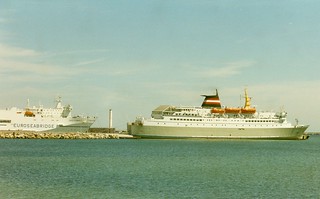 |
| Slide 2: Departure by Ferry |
|
A century after my grandfather was born, I decided to go back to the shtetl. I left Berlin on 20 July 1995, driving north in an old Volkswagen Passat. [Slide 2: Departure by Ferry] I passed Rostock and turned east, through Stralsund, then north onto the island Rugen.
|
 |
| Slide 3: Klaipeda Harbor |
|
On the east coast, at Neu Mukran south of Salßnitz, I boarded a Baltic Sea ferry bound for the Lithuanian coastal city of Klaipeda. [SLIDE 3: KlaipedaHarbor] After a smooth overnight trip under clear skies I arrived in the Old Country on Friday, 21 July.
|
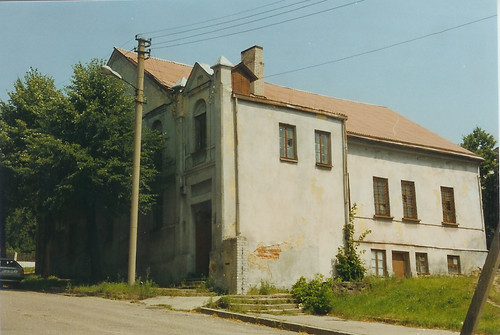 |
| Slide 4: Kovne Shul |
|
From Klaipeda I drove quickly to Kaunas (Kovne), where I joined a minyan for shabbes. [SLIDE 4: KovneShul] After the evening service I met Chaim Bargman, who speaks excellent Yiddish thanks to his mother Gita. She attended the Yavne Yiddish school and survived in the Kovne ghetto. Apart from speaking with them, the highlight during this leg of the trip was seeing the administrative building of the famous Slobodka Yeshiva [SLIDE 5: Swobodka Yeshiva Admin], where two of my ancestors studied in about 1887; (Memoirs, part I, pages 16 and 19). Unlike most of the Jewish quarter, which was destroyed by the Nazis after the Kaunas ghetto uprising, this building survived because it stood outside the walls of the large ghetto.
|
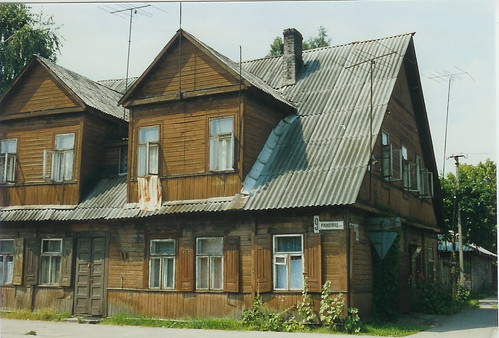 |
| Slide 5: Swobodka Yeshiva Admin |
|
From Kaunas I drove on to Vilnius (Vilna), the so-called Jerusalem of Lithuania. It is becoming a fast-paced cosmopolitan city, but at its heart are traces of the destroyed Vilna ghetto. With the assistance of two Yiddish speakers, Rosa Belauskene and Fanya Brancovskaya, I came to feel both the former glory and the current shambles of Jewish life. There's a Jewish museum, another museum branch dedicated to the Vilna ghetto, a historical archive, a Jewish restaurant, a Judaica section of the National Library, and a synagogue. Vilna was a center of Jewish learning for more than two centuries, until 70,000 Jews were murdered at Ponar (Paneriu), and today only shards remain.
I went to the Ponar site, difficult to locate in a forest to the south of town. The small museum includes a copy of a German document dated 1 December 1941, reporting that "the goal of solving the Jewish problem for Lithuania has been attained." The commander of Einsatzkommando 3 then details every town; he records that on 15-16 August 1941, for example, "3,200 Jews, Jewesses, and Jewish children from Rokishkis; were shot, and on 18 August "493 Jews, 432 Russians, 56 Lithuanians (all active communists)" were killed.
"In Rokishkis, "the commander explains further, "3,208 people were to be transported 4 1/2 km, before they could be liquidated. In order to accomplish this task in 24 hours, more than 60 of 80 available Lithuanian partisans had to be detailed for the transport or the confinement. The remainder, which was again and again relieved, did the job together with my men." He complains that "motorized vehicles are only seldom available. Efforts at escape, which now and then occurred, were prevented exclusively by my men, at their own peril."
|
 |
| Slide 6: Rokishkis Cemetery |
|
My eye was drawn to this part of the document, which I have translated here, because some family ancestors moved from Kvetkai to Rokishkis (Rakishuk). Most of them seem to have left Lithuania in 1913 or earlier, but any relatives who remained until 1941 were almost certainly "liquidated" then. I started to choke when I saw the large pits the Nazis used to dispose of the bodies in Ponar. They were not resting in the cemetery. [SLIDE 6: RokishkisCemetery]
Back in Vilnius, my heavy spirits lifted slightly when I received news from the head archivist at the historical archives on Gerosios Vilties 10. Following my written request of two days earlier, she found extensive documents about my ancestors in northern Lithuania.
The Census of 1895 (probably containing some information from as late as 1897) includes two families that appear in Mendel's memoirs. The first document, from Kvetkai, accounts for the household of my paternal greatgrandfather Avram Ziv (born Milner), listing him and his wife, nine sons, and a maid. The second document, from Rokishkis, lists the inhabitants living with Zalman Milner, Avram's younger brother: his wife, three children, a mother-in-law, and a maid. In Birzai or Poneveyz there must be more records of births, marriages, and deaths in the family, unless they have been lost in wars and fires.
|
 |
| Slide 7: Rokishkis Houses |
|
The next day I headed north with a guide/interpreter to seek out the towns of Kvetkai (Kvatki) and Rokishkis (Rokishuk), as well as the town of Avram Ziv's parents, Zhiobishkis (Zbishak). The first view of Rokishkis is dismaying: one is assaulted by Soviet-era brick and cement houses on modern streets bearing no trace of the past. But further north comes the old part of town. [SLIDE 7: Rokishkis Houses] My interpreter translates for me, speaking Russian; in the future, I now realize, a Lithuanian-English interpreter would be helpful, since in these outlying areas many people do not speak Russian. We pull up to the square in front of the Rokishkis church, which has an unusual brick facade.
|
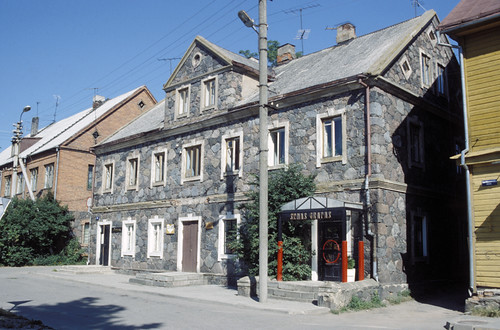 |
| Slide 8: Rokishkis Restaurant |
|
In the small restaurant to the right, [SLIDE 8: Rokishkis Restaurant] a woman offers to show us the town. My interpreter explains in Russian that we have not come here to see the general sites, but rather to find out about the Jewish community of former times. The woman takes us to the Museum, [SLIDE 9: Polish Lord’s Estate] located in the impressive estate of the Polish Count Pshezdetsky.
|
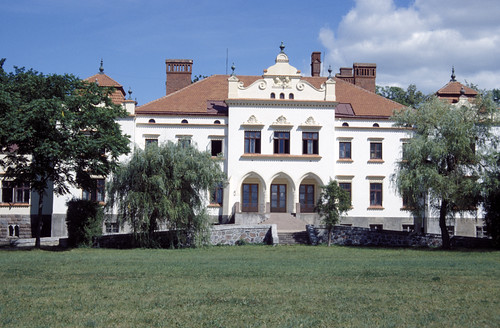 |
| Slide 9: Polish Lord’s Estate |
|
This Polish noble family owned much of the town in the nineteenth century, including the house on Kamaskaya (Kamayu) Street #68 in which a Rubin family, possibly in-laws of the Milners, lived when the census was taken in 1895. [Slide 10: Rokishkis Houses 2]
|
 |
| Slide 10: Rokishkis Houses 2 |
|
A diligent Rokishkis historian, Onute Mackeviciene, has been doing research on the Jews of the town in the early nineteenth century. Our family had not yet arrived there, however, and she tells me that many records from the late nineteenth century were lost during the war.
|
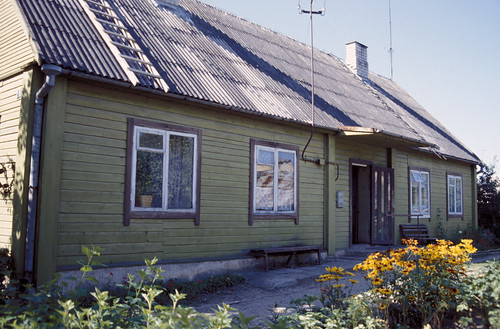 |
| Slide 11: Rokishkis House 3 |
|
She gives me copies of two significant documents: a map of Rokishkis, showing property lots in 1921, and an accompanying list of owners. Around then the Jews of the community were returning from central Russia where they had been sent by Czarist authorities during the war. [Slide 11: Rokishkis House 3]One Milner is listed in house #95, owned by an heir to Count Pshezdetsky, shown on the alleyway between Kamaskaya Street and the next street to the west, which leads to the church. The map shows four nearby synagogues; we did not hear enough oral history to confirm the rumor that all of them were destroyed.
|
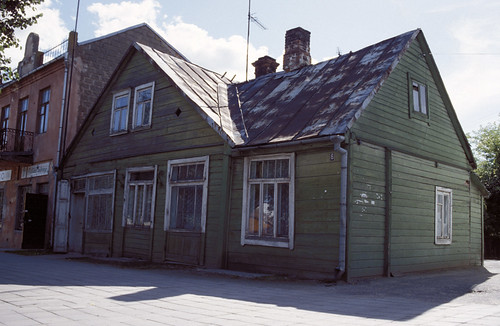 |
| Slide 12: Rokishkis House 4 |
|
Walking around the streets of Rokishkis, in particular along the alley west of Kamaskaya Street, one senses that many of these one-story wooden houses have not changed much in eighty or a hundred years. [SLIDE 12: Rokishkis House 4] About half of them were then owned or leased by Jews. Now this is a kind of ghost town, in the sense that only one Jewish family lives here; and they came from Kamajai after the war. When did the property fall into new hands? One might say that the Nazi genocide effectively shared the spoils of war with local inhabitants.
|
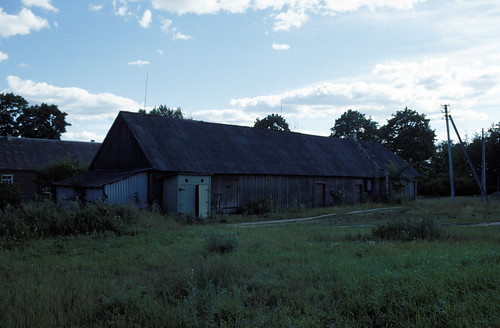 |
| Slide 13: Zhiobiskis farm |
|
I learn that in a place called Stepanov, north of Rokishkis, there is a monument to the 3,000 Jews who were killed by the Nazis with the help of Lithuanian partisans. Then I push onward, traveling north along a dirt road presumably leading past the site--which I miss, of the mass grave. The next stop is Zhiobishkis (Zbishak) [SLIDE 13: Zhiobiskis farm], which Mendel describes in his memoirs as "half farm, half village" (I, 49).
|
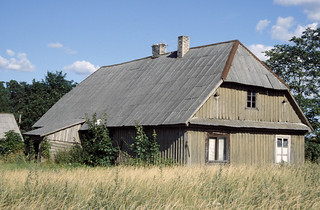 |
| Slide 14: Zhiobiskis 2 |
|
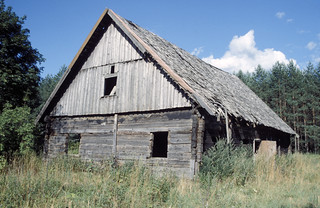 |
| Slide 15: Z. near Panemunis |
|
It hasn't changed much, except that to the west several post-Second World War Soviet brick block houses have been built. In the main section there is one store; [SLIDE 14: Zhiobiskis 2] the other buildings are one-story wooden houses, barns, and shacks. [SLIDE 15: Z. near Panemunis] That's how it was when Mendel visited his grandparents there in the 1880s and 1890s. Sometimes I want to thank the Soviets for leaving things almost the same for half a century, but I know that it was not pleasant for the local inhabitants to dwell in what the visitor sees as a museum of shtetl life.
|
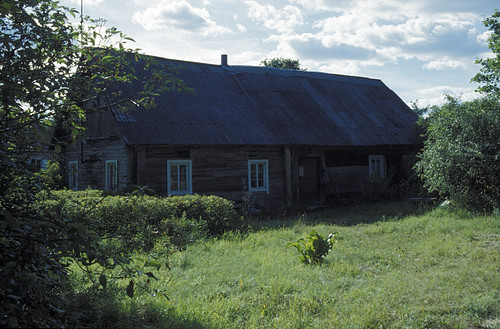 |
| Slide 16, Ziobishkis House |
|
Mendel recalls that "their business was a small store which had everything, and an inn. [SLIDE 16, Ziobishkis House] Many village Jews and those in larger places did the same. It was a dependable income, though no wealth. Only a few Jews lived in the village and vicinity, and on Saturday and holidays they would come to grandfather's home for prayers. There was a special room and a Torah scroll and some books--a sort of small scale synagogue with an Ark and Table for reading the Torah. His son, Zalman, was the Torah reader when he was still a very young boy. In my time, only the youngest, Hayim, lived at home. Even after he got married he remained with them and helped conducting the business. They lived in that village for many years; indeed, until the decree that all Jews were to get out of the rural areas in Russia. Then they moved to the neighboring town of Rakishak [Rokishkis], where three of their sons had been living for some time." This must have been around 1903-5, pogrom years.
From the 1895 Census document, I had the records of Zalman Milner's family in Rokishkis. The head of the household was then 35, about a dozen years younger than his brother Avram, my great grandfather, in Kvetkai. He was the uncle of Alexander, my father's father. It is poignant to know that he was bal korei, and could have read Torah in one of the four synagogues in Rokishkis. According to the census, Zalman had a shop for iron works.
|
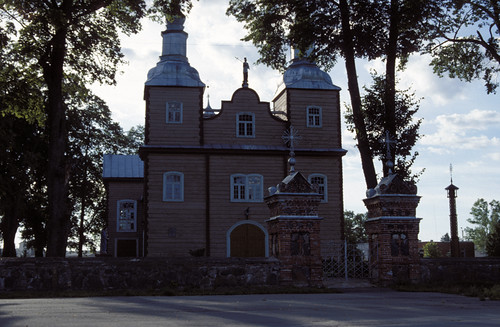 |
| Slide 17: Kvetkai Church |
|
I continued northward, traveling west on dirt roads through Panemunis (Punamunek), where Avram Ziv’s first wife grew up. She died in childbirth, and around this time, in about 1872, Avram moved to Kvetkai (Kvatki). Mendel notes that this town’s name means “flower” in Russian and Lithuanian. Driving northwest on a dirt road, I arrive in Kvetkai [SLIDE 17: Kvetkai Church] and stop in front of the striking wooden church. Mendel includes a long description of this village--our home town, where he was born in 1878 and where my grandfather was born in 1894.
|
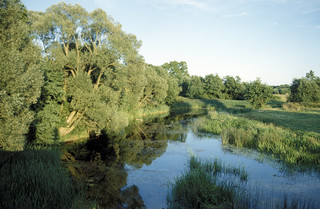 |
| Slide 18: Kvetkai River |
|
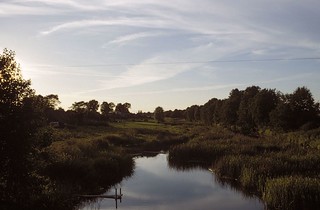 |
| Slide 19: Kvetkai River 2 |
|
First he describes the river, [SLIDE 18: Kvetkai River] which apparently has not changed except for the recently constructed cement bridge that spans it. [SLIDE 19: Kvetkai River 2] Mendel writes that "about 100 families comprised the village population, mostly Jews. Some were craftsmen, some peddlers in the neighboring village, and six storekeepers. [SLIDE 20: Kvetkai House], The mill owners were also Jewish; then there were the rabbi, ritual slaughterer (shochet), synagogue personnel and two teachers, one for the young and one for the more advanced Talmud students" (Memoirs, I, 18). [SLIDE 21: Kvetkai Barn]
|
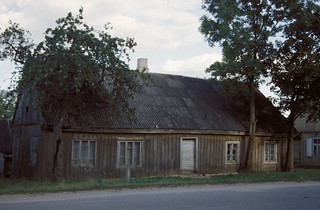 |
| Slide 20: Kvetkai House |
|
 |
| Slide 21: Kvetkai Barn |
|
I found many things as Mendel describes them from a century earlier: [SLIDE 22: Kvetkai Church 2] “The Catholic church stood at the city gate, a beautiful comfortable building…. There was also a government school near the center of the village and it was attended by the children of the peasant folk and some Jewish children” (Memoirs, I, 19). Though I’m not sure about the government school, I saw the synagogue [SLIDE 23: Kvetkai Shul] that is described as being halfway up the street, with a large lot in front.
|
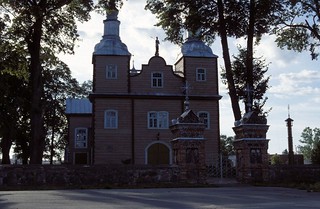 |
| Slide 22: Kvetkai Church 2 |
|
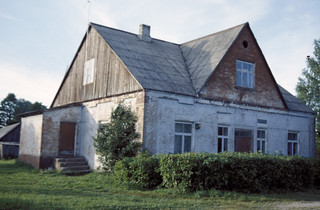 |
| Slide 23: Kvetkai Shul |
|
Mendel writes that his father had a general store on the Kvetkai Square, opposite the church. [SLIDE 24 ;Kvetkai Houses] That's what I photographed immediately, following my intuitions--four one-story wooden houses on the east side of the street, across from the church. During the next visit I hope to check the interiors against Mendel's description: their house was divided in two, "half for the store and the other half for residence" (I, 19). [SLIDE 25: Kvetkai House ZIV] This is “ground zero,” where my grandfather was born and lived a century ago.
|
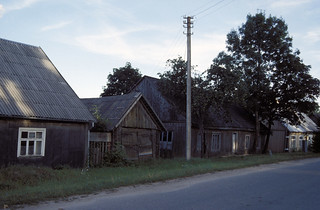 |
| Slide 24: Kvetkai Houses |
|
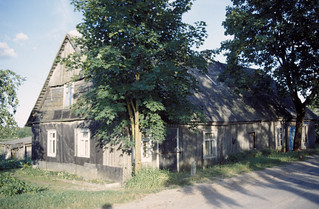 |
| Slide 25: Kvetkai House ZIV |
|
Mendel recalls: "Later, when our business prospered and Father dealt in linens, the apartment became a warehouse and we moved to the other side of the house which we had earlier leased. Then we had more space, and when the family grew larger, we added two more rooms to the building. In this house, which was the third in the number of homes in the single street of the village, we were all born, eight brothers and one sister of our mother, and the eldest son of father by his first wife. Here we grew into adulthood , until the day we left the place, one by one, with changing times and events. My parents remained in that house to the last day before going to the United States" (I, 19).
Later in his memoirs, Mendel further describes Kvetkai, and all of his descriptions match its current state (I, 31-33). But I needed an oral source to locate these things. First I met an elderly man who was very friendly. He introduced me to the town doctor, a pleasant blonde woman who happened to be riding by on her bike, carrying a large metal milk container. She spoke enough Russian to communicate with my interpreter, and she took us to meet the last child from a Jewish family in Kvetkai.
Maria Bainowskene was born Esther in 1923. She's a short woman wearing a colorful scarf over her hair, peeling potatoes for dinner with her husband, who is Lithuanian. She speaks Lithuanian to the doctor, who translates into Russian for my interpreter, who in turn translates for me. Born to a Jewish family, she must have spoken Yiddish until the age of 18; at some point she converted to Christianity. Her house is farther up the street on the right, a few houses past the bridge on the east side of town, close to the river. It consists of an entrance corridor, a kitchen, and a few small rooms. I asked to use the bathroom, and got to see the back yard, a rooster, and some other farm animals, and the outhouse. Few conveniences seem to have been introduced into this shtetl since the Ziv family left in 1913.
Maria-Esther showed us the Jewish part of town, as she remembered it from the 1930s, before the Nazis came. She pointed out two empty lots where the houses and shops of Lifshitz and Gorevitz stood; Mendel mentions Dov Lifshitz as having been one of the two richest men in town, the owner of a flour mill. The other was Avram Ziv, my father’s grandfather (I, 33). Across from the church, she pointed to the former home and store owned by the family Ratsonas. Until 1913, I think, this was the Ziv family house. Then I knew that I had reached the goal of my first pilgrimage back to the shtetl.
Maria-Esther remembers when the Nazis came to Kvetkai in the summer of 1941. All of the Jews—including her entire family—were rounded up and held in a local tower. Then they were killed at that place I had read heard about north of Rokishkis, called Stepanov. Maria-Esther was the only Jew in town to escape death, with the help of a Lithuanian, in the summer of 1941.
|
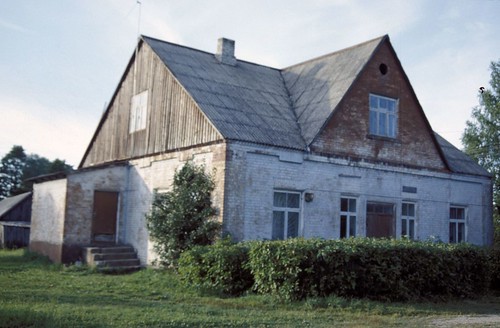 |
| Slide 26: Kvetkai Shul 2 |
|
I don’t want the end this narrative on a note of destruction, but instead with hopes for the rebuilding of European-Jewish life and culture. Now that Jewish communities are firmly established in Israel and the United States, is that possible or desirable for a Jewish community to return to Lithuania? Should descendants of Lithuanian Jews work to establish museums, memorials, or ongoing Jewish cultural institutions? [SLIDE 26: Kvetkai Shul 2] How would the local inhabitants react if we told them, for instance, that we would like to restore the Kvetkai synagogue?
1 M. M. Frieden, Memoirs, part I, p. 33. For a memoir describing the town and the Zyw/Frieden family history, see A Jewish Life on Three Continents: The Memoir of Menachem Mendel Frieden, trans. and ed. Lee Shai Weissbach (Stanford: Stanford University Press, 2013), especially pp. 45-69.
BACK TO THE SHTETL by Ken Frieden
Assisted by Erin O’Neil
1995/Revised 2012
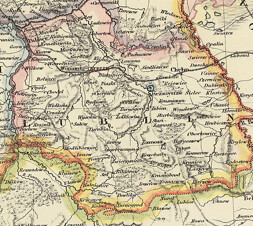


























Hi
I read your post and it contains very useful information. Thanks for this useful article green home construction